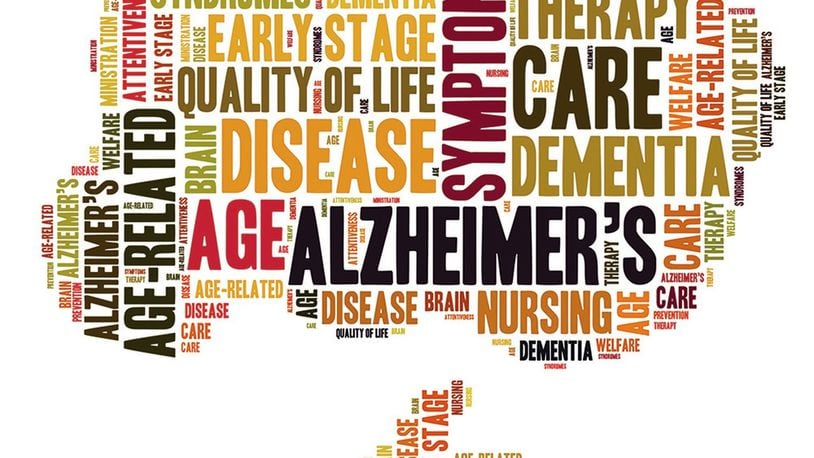Another important action is the creation of a campaign to increase the awareness of changes in the brain as people age so that older adults feel more comfortable having open conversations with family members and health care providers about Alzheimer’s, the resolution said.
Patients at the Wright-Patterson Medical Center who are being evaluated for the possibility of a dementia-related condition are often referred to the Neuropsychology Clinic there for a battery of assessments that help in the diagnosis of Alzheimer’s or other forms of dementia, according to Maj. (Dr.) Earl Banning, director of Neuropsychology at the medical center.
“Early onset patients will perform poorly on attention and concentration tasks – something as simple as ‘I’m going to say five numbers, repeat them back to me.’” ‘Now repeat these numbers back to me backwards.’ They may struggle with that,” said Banning.
The earlier you get the disease, the quicker the symptom progression is. Emotion and personality can change, mostly in the middle to late stages as the disease progresses through the frontal lobes and different areas, said Banning.
“They can have hallucinations, paranoia. They can do what’s called sun downing, which is when the person heads toward the evening, they have confusion and may have more hallucinations and paranoia.”
“With that said, I can tell you that in delivering this news to people, it’s not always bad. There’s good research on this about happiness and diagnoses. When people get diagnosed with a chronic terminal medical condition, oftentimes their mood can decrease, but if you give it enough time, usually they kind of bounce back a little bit – they start to cope with this,” he said.
Sometimes their mood can be a little better because they kind of know what’s going on and they can plan, Banning explained. People are also resilient and come together as a family when faced with these situations.
“For example, I had a couple come in and I gave them the diagnosis after compiling the initial data, but I still did a feedback session several weeks later and they came back and said, ‘You know what, we had always wanted to take this trip over to Norway and we booked it. We’re going to do this,’ and they were pretty happy. They’re looking at what the rest of their lives would look like.”
For neuropsychology, a person might come in and be interviewed by Banning along with their family members for maybe 60-90 minutes to gather information required for a diagnosis. Before their arrival for their first appointment, Banning also reviews the person’s medical records for an understanding of any history of head injuries, diabetes, cardiovascular issues, any type of brain imaging they might have had, or lab results if they’re not normal now.
After meeting with the person and their family, Banning will have the person begin assessment testing. Depending on the person, the testing can take the entire day, with the patient doing all different types of cognitive tests. Banning then scores all the test results, some manually and some that are computerized. After this, he produces a report for the patient.
“What I try to do is to put that all into English – I don’t write an academic paper about Alzheimer’s disease. I write it like I would explain it to you – like this is where I think you were, this is where you are now, this is what you were bad at, and this is what that means for your daily functioning and here’s what I’m recommending to you. I want the loved ones to be able to pick this report up and read it and understand it. I leave the data in the back in case another neuropsychologist wants to look at it and disagree with me or agree with me, but the actual report is written in a way that is understandable to my referral source and to the family members.”
There is a misconception that some people may have about brain imaging and how powerful it is, Banning said.
“There’s a huge disconnect between what your brain looks like and how it functions. That’s where neuropsychology is, because I can look at a picture of your brain and see all kinds of spots here and there, but it might not affect you at all or you may have a pretty impaired brain, but you’re still working, driving, things are going fine versus you have this odd little stroke in an odd little area and it’s catastrophic. The person isn’t functioning. In imaging, it doesn’t look too bad, so you really need to know how well this person is doing now, how bad is this impacting them?”
“You can take a picture of the brain and say, ‘This looks like an Alzheimer’s brain to me.’ Well fine, but what does my prognosis look like? Was the person relatively healthy before this? What stage is the person in? These questions won’t be answered very specifically with a lot of these images and you can’t get an IQ test out of an MRI. You’re not going to know how they’re functioning.”
People across the country are working together to help those afflicted with Alzheimer’s. Researchers are doing a lot in the hopes of one day preventing this disease and others are supporting family members who lovingly look after their family members with the disease.
During National Alzheimer’s Awareness Month, we are asked to honor those we have lost too soon and reemphasize our efforts to ensure more Americans can live their lives with health and happiness.
For more information or learn about how you can help, visit the Alzheimer's Association website at www.alz.org.
Editor's note: This is the third and final article in a series of articles during National Alzheimer's Disease Awareness Month. For the first two articles, go to www.wpafb.af.mil/news.
About the Author
